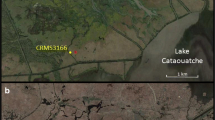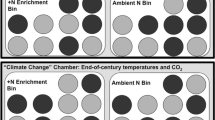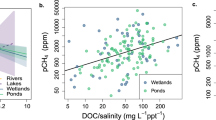Abstract
The relationship between methane emissions and salinity is not well understood in tidal marshes, leading to uncertainty about the net effect of marsh conservation and restoration on greenhouse gas balance. We used published and unpublished field data to investigate the relationships between tidal marsh methane emissions, salinity, and porewater concentrations of methane and sulfate, then used these relationships to consider the balance between methane emissions and soil carbon sequestration. Polyhaline tidal marshes (salinity >18) had significantly lower methane emissions (mean ± sd = 1 ± 2 g m−2 yr−1) than other marshes, and can be expected to decrease radiative forcing when created or restored. There was no significant difference in methane emissions from fresh (salinity = 0–0.5) and mesohaline (5–18) marshes (42 ± 76 and 16 ± 11 g m−2 yr−1, respectively), while oligohaline (0.5–5) marshes had the highest and most variable methane emissions (150 ± 221 g m−2 yr−1). Annual methane emissions were modeled using a linear fit of salinity against log-transformed methane flux (\( \log ({\text{C}}{{\text{H}}_4}) = - 0.056 \times {\text{salinity }} + { 1}{.38} \); r2 = 0.52; p < 0.0001). Managers interested in using marshes as greenhouse gas sinks can assume negligible methane emissions in polyhaline systems, but need to estimate or monitor methane emissions in lower-salinity marshes.



Similar content being viewed by others
References
Bartlett KB, Harriss RC, Sebacher DI (1985) Methane flux from coastal salt marshes. Journal of Geophysical Research-Atmospheres 90:5710–5720
Bartlett KB, Bartlett DS, Harriss RC, Sebacher DI (1987) Methane emissions along a salt-marsh salinity gradient. Biogeochemistry 4:183–202
Bridgham SD, Megonigal JP, Keller JK, Bliss NB, Trettin C (2006) The carbon balance of North American wetlands. Wetlands 26:889–916
Chmura GL, Anisfeld SC, Cahoon DR, Lynch JC (2003) Global carbon sequestration in tidal, saline wetland soils. Global Biogeochemical Cycles 17:1–22
Intergovernmental Panel on Climate Change (2007) Climate Change, 2007. Contribution of working group I to the fourth assessment report of the Intergovernmental Panel on Climate Change, Cambridge
Cornell JA, Craft CB, Megonigal JP (2007) Ecosystem gas exchange across a created salt marsh chronosequence. Wetlands 27:240–250
Craft C (2007) Freshwater input structures soil properties, vertical accretion, and nutrient accumulation of Georgia and U.S. tidal marshes. Limnology and Oceanography 53:1220–1230
Craft CB, Seneca ED, Broome SW (1993) Vertical accretion in microtidal regularly and irregularly flooded estuarine marshes. Estuarine, Coastal, and Shelf Science 37:371–386
Dawes CJ (1998) Marine botany, 2nd edn. Wiley, New York
Delaune RD, Smith CJ, Patrick WH (1983) Methane release from Gulf Coast wetlands. Tellus Series B-Chemical and Physical Meteorology 35:8–15
Emery WJ, Thomson RE (2001) Data analysis methods in physical oceanography. Elsevier, New York
Environmental Protection Agency (1971) Sulfate (colorimetric, automated, chloranilate) Washington, D.C. Method # 375.1
Environmental Protection Agency (2009) Inventory of U.S. greenhouse gas emissions and sinks: 1990–2007. Washington, D.C. EPA 430-R-09-004
Erickson JE, Megonigal JP, Peresta G, Drake BG (2007) Salinity and sea level mediate elevated CO2 effects on C3–C4 plant interactions and tissue nitrogen in a Chesapeake Bay tidal wetland. Global Change Biology 13:202–215
Fofonoff NP, Millard RCJ (1983) Algorithms for computation of fundamental properties of seawater. UNESCO, Paris
Hesslein RH (1976) An in situ sampler for close interval porewater studies. Limnology and Oceanography 21:912–914
Hirota M, Senga Y, Seike Y, Nohara S, Kunii H (2007) Fluxes of carbon dioxide, methane and nitrous oxide in two contrastive fringing zones of coastal lagoon, Lake Nakaumi, Japan. Chemosphere 68:597–603
Insightful Corporation (2001) S-Plus 6 for windows user’s guide. Insightful Corp, Seattle
Institute SAS (1987) SAS/STAT guide for personal computers, version 6 edition. SAS Institute, Cary
Keller JK, Wolf AA, Weisenhorn PB, Drake BG, Megonigal JP (2009) Elevated CO2 affects porewater chemistry in a brackish marsh. Biogeochemistry 96:101–117
Kelley CA, Martens CS, Chanton JP (1990) Variations in sedimentary carbon remineralization rates in the White-Oak River Estuary, North Carolina. Limnology and Oceanography 35:372–383
Kelley CA, Martens CS, Ussler W (1995) Methane dynamics across a tidally flooded riverbank margin. Limnology and Oceanography 40:1112–1129
King GM, Wiebe WJ (1978) Methane release from soils of a Georgia salt marsh. Geochimica Et Cosmochimica Acta 42:343–348
Lyman J (1969) Redefinition of salinity and chlorinity. Limnology and Oceanography 14:928–929
Magenheimer JF, Moore TR, Chmura GL, Daoust RJ (1996) Methane and carbon dioxide flux from a macrotidal salt marsh, Bay of Fundy, New Brunswick Canada. Estuaries 19:139–145
Marsh AS, Rasse DP, Drake BG, Megonigal JP (2005) Effect of elevated CO2 on carbon pools and fluxes in a brackish marsh. Estuaries 28:694–704
McAullife C (1971) GC determination of solutes by multiple phase equilibrium. Journal of Chemical Technology 1:46–51
McKee KL, Mendelssohn IA, Hester MW (1988) Reexamination of porewater sulfide concentrations and redox potentials near the aerial roots of Rhizophora-Mangle and Avicennia-Germinans. American Journal of Botany 75:1352–1359
Megonigal JP, Schlesinger WH (2002) Methane-limited methanotrophy in tidal freshwater swamps. Global Biogeochemical Cycles 16:1088. doi:10.1029/2001GB001594
Megonigal JP, Hines ME, Visscher PT (2004) Anaerobic metabolism: linkages to trace gases and aerobic processes. In: Schlesinger WH (ed) Biogeochemistry. Elsevier-Pergamon, Oxford, pp 317–424
Nedwell DB, Embley TM, Purdy KJ (2004) Sulphate reduction, methanogenesis and phylogenetics of the sulphate reducing bacterial communities along an estuarine gradient. Aquatic Microbial Ecology 37:209–217
Nellemann C, Corcoran E, Duarte CM, Valdés L, DeYoung C, Fonseca L, Grimsditch GE (2009) Blue Carbon. A Rapid Response Assessment. United Nations Environment Programme, GRID-Arendal, Norway
Neubauer SC (2008) Contributions of mineral and organic components of tidal freshwater marsh accretion. Estuarine, Coastal and Shelf Science 78:78–88
Neubauer SC, Miller WD, Anderson IC (2000) Carbon cycling in a tidal freshwater marsh ecosystem: a carbon gas flux study. Marine Ecology Progress Series 199:13–30
Rejmankova E, Post RA (1996) Methane in sulfate-rich and sulfate-poor wetland sediments. Biogeochemistry 34:57–70
Schlesinger WH (1997) Biogeochemistry: an analysis of global change, 2nd edn. Academic, San Diego
Sebacher DI, Harriss RC (1982) A system for measuring methane fluxes from inland and coastal wetland environments. Journal of Environmental Quality 11:34–37
Senior E, Lindstrom EB, Banat IM, Nedwell DB (1982) Sulfate reduction and methanogenesis in the sediment of a saltmarsh on the east coast of the United Kingdom. Applied and Environmental Microbiology 43:987–996
Sutton-Grier AS, Megonigal JP (2011) Plant species traits regulate methane production in freshwater wetland soils. Soil Biology and Biochemistry 43:413–420
Tong C, Wang W-Q, Zeng C-S, Marrs R (2010) Methane (CH4) emission from a tidal marsh in the Min River estuary, southeast China. Journal of Environmental Science and Health Part A 45:506–516
Van der Nat FJ, Middelburg JJ (2000) Methane emission from tidal freshwater marshes. Biogeochemistry 49:103–121
Wang ZP, Zeng D, Patrick WH (1996) Methane emissions from natural wetlands. Environmental Monitoring and Assessment 42:143–161
Wang D, Chen Z, Xu S (2009) Methane emission from Yangtze estuarine wetland, China. Journal of Geophysical Research 114:GO2011
Watson R, Noble I, Bolin B, Ravindranath NH, Verardo DH, Dokken DJ (2000) Land use, land-use change, and forestry. Intergovernmental Panel on Climate Change, Montreal
Weston NB, Vile MA, Neubauer SC, Velinsky DJ (2011) Accelerated microbial organic matter mineralization following salt-water intrusion into tidal freshwater marsh soils. Biogeochemistry 102:135–151
Whalen SC (2005) Biogeochemistry of methane exchange between natural wetlands and the atmosphere. Environmental Engineering Science 22:73–94
Whigham DF (2009) Primary production in tidal freshwater wetlands. In: Barendregt A, Whigham DF, Baldwin AH (eds) Tidal freshwater wetlands. Margraf and Backhuys Publishers, Leiden and Weikersheim, pp 115–121
Whiting GJ, Chanton JP (2001) Greenhouse carbon balance of wetlands: methane emission versus carbon sequestration. Tellus Series B-Chemical and Physical Meteorology 53:521–528
Winfrey MR, Ward DM (1983) Substrates for sulfate reduction and methane production in intertidal sediments. Applied and Environmental Microbiology 45:193–199
Wylynko D (ed) (1999) Prairie wetlands and carbon sequestration: Assessing sinks under the Kyoto Protocol. IISD, Ducks Unlimited Canada, Wetlands International, Winnipeg
Acknowledgments
We thank Andrew Baldwin, Raymond Crew, Emily Hutchins, Miriam Meyers, Nicholas Mudd, Jim Duls, Caitlin Megonigal and U.S. Fish and Wildlife Service staff at the Blackwater Natural Wildlife Refuge. This work was supported by funding from the Maryland Department of Natural Resources Power Plant Research Program.
Author information
Authors and Affiliations
Corresponding authors
Electronic supplementary material
Below is the link to the electronic supplementary material.
Online Resources
(DOC 121 kb)
Rights and permissions
About this article
Cite this article
Poffenbarger, H.J., Needelman, B.A. & Megonigal, J.P. Salinity Influence on Methane Emissions from Tidal Marshes. Wetlands 31, 831–842 (2011). https://doi.org/10.1007/s13157-011-0197-0
Received:
Accepted:
Published:
Issue Date:
DOI: https://doi.org/10.1007/s13157-011-0197-0




